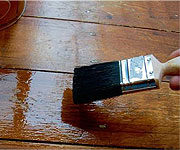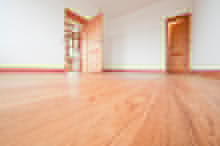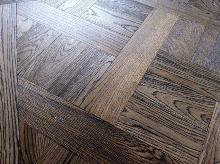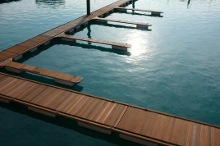FLOOR SANDING & FINISHING
The sanding and finishing process is well known as being the key to bringing your timber floors and stairs to life. Vanguard Timber Flooring also specialise in the restoration and maintenance of all time inside and out. When is come to making a decision on the type of finish and look to choose it’s best to first decide on the best colour works best and wether you want a shiny or natural look.
To help who are not up on specialist coating understand their choices we put a list together of some different products and our services which came from years of experience and the research conducted by the Australian Timber Flooring Association “ATFA” and Industry Manufactures.

SOLVENT-BORNE POLYURETHANE
This coating product provides the highest durability and film build of all coating types as well as the highest loss levels for the gloss option if you are after the ultimate “BLING FACTOR”. This product is also the cheapest option and can last eight to twelve years in most cases before needing a maintenance coat.
After the flooring is sanded and clean a fast drying sealer coating is applied followed by the first coating off polyurethane. The flooring is then left overnight and then lightly buffed before applying the final coating. All solvent-borne coatings are applied using rollers and brushes and cause toxic vapours so it’s best not to stay in house while coatings dry.
The down side to using this product starts with the toxic smell, long chemical curing times and sometimes this product will reject if traces of silicon are present.
Other things to consider include that the polyurethane “plastic” will go a yellow – orange colour in time because of the UV effect sunlight has on the chemicals in the product, because of this some areas on red timber floors can be damaged so badly it looks like a yellow/orange species and the only solution is to sand the floor back to bare timber and start again.
Also any scratches will normally stand out more being a brighter white.

WATER-BORNE POLYURETHANE
The Commercial Grade two-pack water-borne polyurethane products Vanguard Timber Flooring use have many benefits over the cheaper solvent-borne option, such as an absence of any strong solvent smells on application and much faster drying times.
After the flooring is sanded and clean a sealer coating is applied followed by the first coating off polyurethane. The flooring is then left overnight and then lightly buffed before applying the final coating. All Coatings in this process are done using rollers and brushes or dragged on using special foam applicators.
This type of finish looks more natural than the solvent-borne finish, it gets between loose floorboards and parquetry blocks to glue and seal them tight, also it does not change colour as much from UV light and scratches will not stand out as much.
The downside to this type of finish is that it goes darker when exposed to UV’s from sunlight (less visible change compared to solvent-borne finishes) and will need recoating after 8-10 years normally or the coating may need to be sanded off back to bare timber and start again.

TRADITIONAL STAINS
This process involves wiping special coloured liquid directly into the grain on the wooden floor and then wiping off the excess in a consistent manner. Traditional staining will always make wooden floors look better as the full potential of the grain punches through to reveal grain and timber density lines that were once hidden. Apart from making any timber floor look better, staining is also great to disguise different timer species, colour match furniture, and hide stains and water damage to some degree.
There are many colours and colour variations that can be created using staining products Vanguard Timber Flooring.

TINTED POLYURETHANE
This staining method is the cheapest and easiest to do as the colour is in a special polyurethane mix so it can be rolled and brushed on with little extra effort to change the colour of a floor by putting a coloured tint in the plastic coating.
There are two main downsides to using this type of staining method. The first is that it will not highlight the grain and bring the amazing wooden grain patterns to life. As the plastic polyurethane finish wears so will the colour in some areas more than others leaving an undesirable effect that will need to be sanded off back to bare timer to fix if regular maintenance coatings are not applied.

BLEACHING
Bleaching timber flooring and stairs will make timber species change to a honey golden colour with the colour variation that appears similar to the species Blackbutt or some Oak species.
This process is commonly used in Brisbane and the Gold Coast to make the pinkish looking Brush Box species into something with a lighter more modern appeal and is also great to disguise mixed species

WAX
Wax coatings have advanced tremendously over time, and with Whittle Waxes producing some new age Hard Wax Oil timber finishes for the Australian Market.
It is easy to maintain and unlike polyurethanes, it will not be necessary to re-sand the whole floor for repairs or to replenish. The Hard Wax Oils contain no pollutants and minimal solvent content.
This type of finish has a natural appeal with a slight sheen and comes in clear or a wide range of unique pre coloured oil effects that will give any floor natural charm and beauty.

WOCA – PENETRATING HARDENING OIL
This product can produce the most beautiful wooden floor effects and be sure to keep in mind that “these oils are not just oils”. It’s got to be our pick!
After the timber flooring is sanded and dust free the process would involve first washing the floor with a special wood cleaner to pop the grain so the oil can penetrate well. Normally the following day oil or sometimes a primer is applied before oiling by mechanically buffing the oils deep into the grain.
The end result is a floor that has an awesome raw popped grain feel normally, however if another light sand and oil coating is applied a smooth sheen can be produced. The “Diamond Oil” is the clear oil finish and there are also grey and white primers and many oil mixed colours to create effects such as “Old Drift Wood”.
It is easy to maintain and unlike polyurethanes, it will not be necessary to re-sand the whole floor for repairs or to replenish. The WOCA Oils contain no pollutants and minimal solvent content.

TIMBER DECKING, JETTIES AND STEPS
Water is timber’s greatest enemy as it takes in moisture it can rot, so after the outdoor timber decks, walls, doors and steps have been carefully sanded and cleaned it’s very important to not skimp on the protective coating you choose to enhance the timbers beauty.
Most stains attempt to control water and water vapour from forming a surface film. However, in only a short time UV and wear causes film break down which allows water and water vapour into the wood. As moisture moves in and out of the timber it causes shrinkage and swelling, splitting, loss of dimensional stability, greater susceptibility to environmental degradation.
Cutek is the ultimate product of choice for the protection and restoration of timber decking and stair treads. Cheaper alternatives can be applied, however it’s important to remember that you get what you pay for, and in this case it looks the best and lasts longer than other products to date so it will save you time and money in the end. The oil many unique colours, with some popular colours being “Black Ash”, “Burnt Red”, “Walnut” and “Chestnut”.
Cutek does not form a film, so does not need to be removed before recoating. Cutek works by diffusing through the timber controlling moisture from the inside. The moisture rate exchange between wood and the environment is greatly slowed down as the timber is stabilised by controlling moisture for many years.
Vanguard Timber Flooring also specialise in other service for outdoor timber restoration and maintenance projects including outdoor furniture, timber garage doors, timber gates, timber walls and timber doors.

